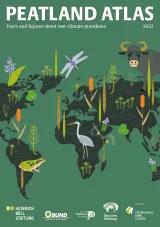
For thousands of years, peatlands have served as the backdrop for horror stories. In gruesome legends and lore, they swallow people and even whole towns, are the home of ghosts, the devil, and many other supernatural spectacles.

If our ancestors had come up with the idea of equipping the world with information boards and warning signs, the pathways to peatlands would long ago have been decorated with signs saying things like “Warning: Entrance to Hell” or “Caution: Beware of the ghosts”. Many a solitary wanderer who ventured into a peatland was never seen again. What could possibly be to blame, if not the evil beings that lurked in these inhospitable places? The legends of such dangerous outings through the peatlands at night were crystallized into a well-known poem by the German author Annette von Droste-Hülshoff, whose “Boy on the Moor” is haunted by all the eerie noises and figures that local legends can offer: unholy spinners, a cursed woman, and ghostly gravediggers. All are damned souls from whom only the innocent can, with luck, escape.
There even exist legends of peatlands that have engulfed entire villages and towns. Some of these contain a historical kernel of truth, as with a village in the Red Moor of the Rhön, a range of hills in central Germany, that was in fact destroyed in the Thirty Years War. In another legend, a village was overtaken by divine punishment. It sank into the waters because of the sinful lives of its inhabitants. According to sayings, spooky voices can be heard at night, and on particularly holy days, the town rises so high that in the hours before midnight, its church spires can be seen emerging above the surface.
In Ireland, people still talk about the púca, or pooka: a mythical being that wanders through the bogs and can take on different forms – a black horse, a rabbit, or a human. The púca is always up to something. The Irish historian P. W. Joyce describes its deceitful nature “as a contradictory mix of merriment and malignity”. The Okavango Delta in Botswana is guarded by a mythical, dragon-like snake called Mukisi. This Mukisi is a type of demon that protects the whole river system from overuse. If one were to kill the Mukisi, everything else would die along with it. Such guards have a monumental task: they try to protect remote, scarcely touched environments that are threatened on all sides, for example by forest fires, droughts, habitat destruction, industrial development, excessive hunting and charcoal production, as well as by the wounds left to following generations by colonialism, war and the displacement of Indigenous peoples.
Will-o’-the-wisps have a firm place in the mythology of peatlands. Eyewitnesses describe them as bright flames, sometimes as jumping blue flames, or perhaps as similar to candlelight. This variability may have contributed to the different roles they play in the world of legends: sometimes as the souls of the deceased who must wander the Earth for all eternity because of their evil deeds, or as the souls of the victims of murder, who cannot find their rest. Or as goblinlike creatures who either guide travellers on their way through the peatland, or lead them to their ruin, or simply play tricks on them. Today we explain the phenomenon of will-o’-the-wisps as gases produced by the rotting of organic material that spontaneously ignite when they escape from the ground.
Peatlands were long regarded as areas that do not belong to this world. They are a kind of intermediate realm, neither water nor land. They symbolize the manifold functions of water, which stands for life, renewal and cleansing, but also for death and destruction. Peat water was allocated powers of healing and fertility, and today people still enjoy the effects of moor bathing – immersing themselves in a mix of peat and water from the peatland. But on the other hand, peatlands were places for punishment, where sacrilegious deeds or ways of life were to be atoned for. This happened not just in legends, but also in fact. The evidence for this takes the form of the so-called bog bodies.
For hundreds of years, peat cutters have repeatedly found corpses whose well-preserved status made people of the time uneasy. We now know that the lack of oxygen and the highly acidic environment slows down the process of decomposition. But it is still not completely clear how such bog bodies came about. Some show signs of “overkill” – multiple possible causes of death – such as Lindow Man from England, who had axe blows to the skull, knife wounds in the chest and signs of strangulation. One theory is that criminals were executed in the peatland; another is that human sacrifices were made there. There are also bodies that were buried after a natural death. It is thought that the peatland was used for emergency burials, as the last resting place for people who were excluded from society.
“Death for the first, misery for the second, bread for the third” goes a German saying that summarizes the experiences of three generations to transform the Teufelsmoor, large peatlands near Bremen in northern Germany to wrest cultivable fields from it, or to cut peat – once an important fuel like lignite. One might add a fourth phrase to the saying: “Pictures for the fourth.” At the end of the 19th century, numerous artists settled in northern Germany. They founded a famous artists’ colony in the village of Worpswede, on the edge of the Teufelsmoor. Through their paintings of the barren landscape and the life of poor farmers in the area, they developed their own visual language, a modern, realistic and nonetheless legendary image of the peatlands.

